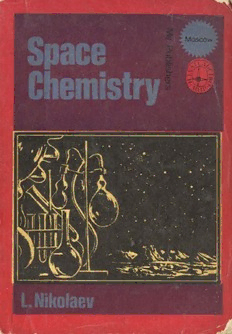
Space Chemistry PDF
Preview Space Chemistry
JI. A. HlIKOJIaeB M3AaTeJlLCTBO XlfMIIH KOCMOCA «11pOCBe~eHHe» MOCKB8 Space Chemistry L. NIKOLAEV Translated from the Russian by Y. NADLER l\1ir Publishers Moscow The Greek Alphabet Aa Alpha I .. Iota Pp Rho B~ Beta Kx Kappa ~(J' Sigma ry Gamma AA Lambda T't Tau f16 Delta MJ.t Mu r" Upsilon EB Epsilon Nv Nu (1)cp Phi Z~ Zeta 8~ Xi Xx Chi Hl1 Eta 00 Omicron '1''1' Psi 8,e) Theta TIn Pi Qoo Omega First published 1976 © English translation, Revised from the 1974 Mir Publishers, 1976 Russian edition CONTENTS Fromthe Author 7 Chapter I. Research Methods Used in Space Chemistry 12 1. Light Rays and Chemical Composition 12 2. "Optical Specifications" of an Atom 16 3. Cosmic Matter on the Earth 24 4. Analytical Procedures and Techniques 29 Chapter II. Chemical Composition of Celestial Bodies. The Solar System 37 1. Meteorites . . 37 2. Chemistry of the Solar System 53 3. The Sun and Planets of the Solar System 56 4. The Planets 65 Chapter III. Scope of Earth and Space Chemistry 94 1. General.. . 94 2. What Happens to Matter at High Pressure 97 3. What Happens to Matter at High Temperatures 100 4. Plasma State of Matter 103 Chapter IV. The World of Stars 107 1. Brightness and Luminosity of Stars . . . .. 107 2. The Hertzsprung-Russell (HR) Diagram and Stel- lar Evolution ..... 108 3. Chemical Composition of Stars 112 4. Stellar Atmospheres. Light and Gravitation 120 5. Novae . 123 6. Supernovae 126 7. Comets • . . 127 5 Chapter V. Nuclear Reactions and Sources of Stellar Energy 129 1. Constituents of the Atomic Nucleus . 129 2. Properties of Some Elementary Particles 132 3. Nuclear Reactions 135 4. Nuclear Energy Sources 136 5. Types of Nuclear Reactions 140 6. Sources of Solar Energy 145 Chapter VI. Evolution of Stars and Synthesis of Elements 151 1. Stages in the Life History of Stars . . . . . . 15'1 2. The Most Important Nuclear Reactions in Stars 162 3. Interstellar Matter . . . . . . . • 166 4. Possibility of Formation of Organic Compounds Due to Action of Protons in Solar and Cosmic Radiation . . . 168 5. Chemistry and Cosmology 169 Chapter VII. Prtmary Synthesis of Organic Compounds 174 1. Physical Factors which Affect Synthesis 174 2. Action of Light on Matter 176 3. Relative Role of Various Energy Sources in Synthesis of Primary Organic Compounds . 181 4. Principal Types of Chemical Processes in Space 190 Index 193 FROM THE AUTHOR Space chemistry Is a science of the near future. Rapid progress in the field of chemical research of the planets,starsand nebulaehas resultedfrom thedevelop ment and application of such sophisticated chemical and physicalresearch techniquesasultraviolet, infrared and radio spectroscopy, as well as the study of X-ray radiation and the magnetic fields of distant celestial bodies. At the present time much of the data obtained has. been verified. The manned space flights and the flights of.automatic interplanetary stations have ope ned the way for the direct analysis of the chemical composition of the planets and the study of the inters tellar medium under conditions that have heretofore been impossible. The numberofhypothesesandassump tions still remaining in space chemistry is constantly decreasing, while the general picture ofelement synthe sis in the interior of stars and the close connection bet ween the evolution of stars and the chemical processes that occur in them are becoming more clearly defined. The practical application of space chemistry is of no mean significance: the precise knowledge of the conditions of future space flights, the study of the effect ofsolar activity on the state ofthe Earth's atmo sphere and the health of its inhabitants-all this 7
